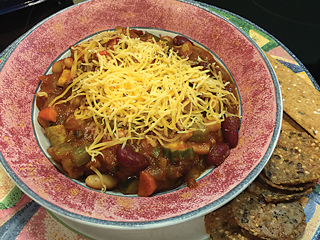Plant-based recipes contain a variety of healthy ingredients that can help lower your risk of heart disease and cancer. For example, beans are rich in potassium, magnesium, folate, iron, and zinc, and they are an important protein source in plant-based diets. They also contain plenty of fiber, both insoluble and soluble. Both types of fiber keep the gastrointestinal tract healthy and help fill you up, promoting satiety and helping control weight. Research suggests that beans can lower our risk for diabetes and heart disease, reduce cholesterol, and favorably impact risk factors for metabolic syndrome.
Another group of substances, phytochemicals (plant pigments), are responsible for the color, flavor, and odor of many vegetables. Phytochemicals have been linked to reductions in the risk of many chronic illnesses.
With all of these healthy benefits, why wouldn’t you want to give these recipes a try?
Avocado, Black Bean, and Brown Rice Salad
Place 1 cup cooked brown rice in a medium-to large-sized bowl. Add one 14-oz can reduced-sodium black beans, a 14-oz can of corn, 1 diced bell pepper, and ½ cup chopped cilantro. To make a dressing, in a small bowl, whisk together the juice from 2 limes, 1/3 cup extra-virgin olive oil, 2 teaspoons turmeric, 1 teaspoon black pepper, and 1 teaspoon salt. Stir the dressing into the brown rice, bean, and bell pepper mixture. Cover and refrigerate the dressed salad for at least an hour before serving. Top each serving with 3 to 4 pieces diced avocado. Quinoa can be substituted for brown rice (be certain to rinse the quinoa before cooking). Diced fresh tomatoes can be substituted for the bell pepper. (Quinoa and tomato substitutes are pictured here.)

Three-Bean Chili
In a large skillet or pot, heat 2 tablespoons extra-virgin olive oil, and sauté 2 large, coarsely chopped onions and 3 coarsely chopped garlic cloves until soft. Dice 2 medium carrots, 2 medium zucchinis, and 1 celery stalk. Add it to the skillet, and sauté for an additional 5 minutes. Combine: 28-oz can puréed tomatoes, 1 chopped green pepper, 1 teaspoon ground cumin, 2 tablespoons chili powder, ½ teaspoon dried white or black pepper. Bring the mixture to a simmer, and stir frequently, for 20 minutes. Rinse and drain: 15-oz can garbanzo beans, 15-oz can red kidney beans, and half a can (8 ounces) of cannellini beans. Add the beans to the other vegetables. Cook until thoroughly heated for about 10 minutes. In the final minute of cooking, add ½ cup chopped cilantro. Season with salt and pepper to taste. If desired, sprinkle with diced scallions, grated cheddar cheese, and/or a dollop of sour cream or plain yogurt. To cut back on sodium, use reduced-sodium or no-salt-added canned beans.
The recipe calls for about 30 to 40 ounces of beans, but don’t limit yourself to the beans suggested here. You can use four or five different beans for this dish. To sweeten things a bit, a little frozen corn can be added to balance the spice of the chili powder. Also, consider using additional garlic, or hot chilies for additional zip.

Simple Seedy Slaw
In a medium-size serving bowl, combine 2 cups each: finely sliced purple cabbage, finely sliced green cabbage, shredded carrots. Add ¼ cup chopped flat leaf or curly parsley to the bowl and mix. Place ¾ cup mixed seeds (equal parts green pumpkin, poppy, and sesame) in a small skillet and toast over medium heat, stirring frequently so the seeds don’t burn, until the seeds are fragrant and the pumpkin seeds start to make popping sounds. Allow the seeds to cool, and add them to the mixing bowl with the chopped vegetables. Toss to combine.
To make the dressing, combine ¼ cup extra-virgin olive oil with 2 to 3 tablespoons fresh lemon juice in a small bowl. Add 1 to 2 cloves pressed or minced garlic, ½ teaspoon cumin, and ½ teaspoon salt (if desired), and whisk until well-blended. Drizzle the dressing over the slaw and toss until all of the ingredients are lightly coated. Add more lemon juice if desired. You can serve this immediately, or cover and refrigerate it to marinate for up to several hours. If you prefer a more finely chopped coleslaw, you can use a box grater or food processor to chop the cabbages. Also, chopped spinach can be substituted for the parsley, if desired. (Lightly adapted with permission from cookieandkate.com)





